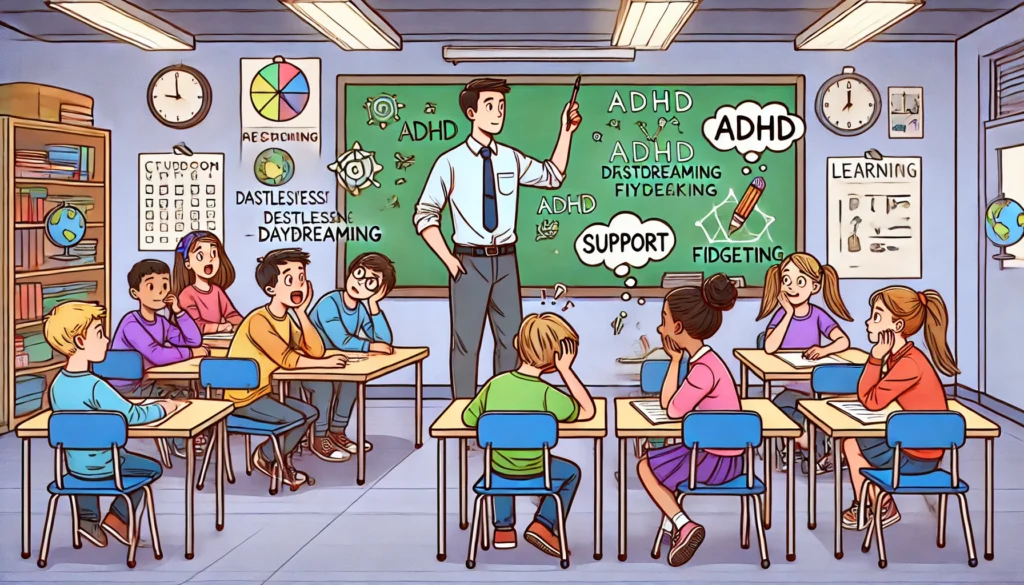Attention Deficit Hyperactivity Disorder (ADHD) is a term that resonates with many, yet its nature and prevalence remain subjects of debate. Is it a common condition that affects a significant portion of the population, or is it a rare disorder with limited impact? This article delves into the complexities of ADHD, exploring its historical context, current prevalence, and implications for the future.
You may also like: Enhancing Concentration: Strategies for ADHD
Understanding ADHD: A Historical Perspective
ADHD is not a modern phenomenon. Historical accounts suggest that the symptoms associated with ADHD have been observed for centuries. However, it wasn’t until the late 20th century that ADHD was formally recognized as a medical condition. The shift from seeing these behaviors as mere eccentricities to identifying them as symptoms of a disorder marked a significant change in the medical community’s approach.
Early Observations and Descriptions
Historical texts and accounts have documented behaviors that resemble ADHD symptoms for centuries. Physicians and scholars from the 18th and 19th centuries noted characteristics such as impulsivity and restlessness in children. These early observations laid the groundwork for understanding the disorder, even if the terminology and diagnostic criteria were not yet developed.
The Emergence of ADHD as a Medical Diagnosis
The formal recognition of ADHD as a medical condition came in the late 20th century. The introduction of standardized diagnostic criteria in the Diagnostic and Statistical Manual of Mental Disorders (DSM) helped clinicians identify and categorize the symptoms. This formalization marked a shift towards understanding ADHD as a neurodevelopmental disorder, moving away from viewing it as a character flaw or parenting issue.
Evolution of Treatment Approaches
The evolution of ADHD diagnosis and treatment reflects broader trends in the field of psychiatry, particularly the increasing reliance on diagnostic criteria and standardized testing. Initially, treatment was limited to behavioral interventions, but the discovery of stimulant medications like methylphenidate in the mid-20th century revolutionized ADHD management. This shift has enabled more accurate diagnoses but has also contributed to debates about over-diagnosis and the medicalization of childhood behavior.
Is ADHD Rare or Common?
When discussing whether ADHD is rare or common, we must consider several factors, including diagnostic criteria, cultural perceptions, and reporting practices. According to the Centers for Disease Control and Prevention (CDC), approximately 9.4% of children in the United States have been diagnosed with ADHD. This statistic suggests that ADHD is relatively common, affecting millions of individuals across various demographics.
Diagnostic Criteria and Their Impact
The criteria for diagnosing ADHD have evolved over time, influencing perceptions of its prevalence. The DSM has expanded its definitions, leading to increased recognition of the disorder. Each revision of the DSM can impact diagnosis rates, as newer editions may encompass a broader range of symptoms and severities, thus affecting prevalence statistics.
Cultural Perceptions and Stigma
Cultural perceptions play a significant role in how ADHD is viewed and diagnosed. In some cultures, symptoms of ADHD may be interpreted as normal childhood behavior, while in others, they are seen as signs of a disorder. Stigma around mental health and neurodevelopmental disorders can also affect whether individuals seek diagnosis and treatment, influencing reported prevalence rates.
Reporting Practices and Their Variability
Reporting practices vary widely between countries, affecting global estimates of ADHD prevalence. In some regions, comprehensive healthcare systems and awareness campaigns may lead to higher diagnosis rates. In contrast, limited access to healthcare and low awareness in other regions may result in underreporting, skewing global prevalence data.
The Role of Gender in ADHD Diagnosis
Gender differences in ADHD diagnosis have been observed, with boys more frequently diagnosed than girls. This discrepancy may be due to different symptom presentations; boys often exhibit more overt hyperactive behaviors, while girls may display more subtle inattentive symptoms. As awareness of these differences grows, there is a push to refine diagnostic criteria to ensure all individuals receive appropriate evaluation and support.

ADHD in Adults: A Growing Recognition
While ADHD is often associated with children, it is increasingly recognized as a condition that can persist into adulthood. Adult ADHD prevalence is estimated at around 2.5%, according to the American Psychiatric Association. This recognition has led to more adults seeking diagnosis and treatment, emphasizing the need for awareness and understanding of ADHD beyond childhood.
The Challenges of Adult Diagnosis
Diagnosing ADHD in adults presents unique challenges. Many adults may have developed coping mechanisms that mask symptoms, making diagnosis more complex. Additionally, adults often present with co-occurring mental health conditions, such as anxiety or depression, which can complicate the diagnostic process and require a nuanced approach.
Impact on Adult Life and Relationships
ADHD in adults can significantly impact various aspects of life, including work performance and relationships. Difficulties with time management, organization, and maintaining focus can hinder career advancement. In relationships, impulsivity and emotional dysregulation may lead to misunderstandings and conflicts, emphasizing the need for effective management strategies.
Treatment Options for Adults
Treatment for adult ADHD often mirrors that of children, involving a combination of medication and therapy. Cognitive-behavioral therapy (CBT) is particularly beneficial for adults, helping them develop strategies to manage symptoms and improve daily functioning. Medication, such as stimulants and non-stimulants, remains a cornerstone of treatment, though the approach may be tailored to address adult-specific challenges.
Increasing Awareness and Resources
As awareness of adult ADHD grows, so too does the availability of resources and support. Online communities, educational programs, and workplace accommodations are emerging to assist adults in managing their condition. This growing recognition fosters a more supportive environment, encouraging adults to seek help and embrace their unique strengths.

Current Trends and Future Implications
The increasing recognition of ADHD as a common condition has significant implications for public health, education, and policy. As awareness grows, so too does the demand for resources and support for individuals with ADHD and their families.
Educational and Workplace Accommodations
In educational settings, accommodations such as individualized education plans (IEPs) and 504 plans are essential for supporting students with ADHD. These accommodations can include extended test times, alternative assessment methods, and behavioral interventions. Similar considerations are being made in the workplace, where flexible work arrangements and supportive policies can help adults with ADHD thrive professionally.
Advances in Treatment and Management
The treatment of ADHD typically involves a combination of medication, behavioral therapy, and lifestyle modifications. Stimulant medications like methylphenidate and amphetamines are commonly prescribed and have been shown to be effective in managing symptoms. However, non-pharmacological interventions, such as cognitive-behavioral therapy (CBT) and mindfulness-based approaches, are gaining traction as complementary treatments.
The future of ADHD treatment may lie in personalized medicine, where interventions are tailored to an individual’s unique genetic and environmental profile. This approach holds promise for improving treatment efficacy and reducing side effects.
The Role of Technology in ADHD Management
Emerging technologies, such as digital therapeutics and mobile health applications, are poised to revolutionize ADHD management. These tools offer real-time symptom tracking, behavioral interventions, and personalized feedback, empowering individuals with ADHD to take control of their condition.
Moreover, advancements in neuroimaging and genetics are enhancing our understanding of the biological underpinnings of ADHD. These insights could lead to novel treatment strategies and improved diagnostic accuracy, ultimately transforming the landscape of ADHD care.
Policy and Advocacy for ADHD
The growing recognition of ADHD calls for policy changes and advocacy efforts to ensure adequate support and resources. Governments and organizations are increasingly focused on creating inclusive policies that address the needs of individuals with ADHD. Advocacy groups play a crucial role in raising awareness, reducing stigma, and promoting research, ultimately shaping a more supportive environment for those affected by ADHD.
The Economic Impact of ADHD
ADHD has significant economic implications, affecting healthcare costs, productivity, and educational outcomes. The financial burden on families and healthcare systems underscores the need for effective management strategies. By investing in early diagnosis and intervention, societies can mitigate these costs and improve the quality of life for individuals with ADHD, ultimately benefiting the broader community.

Conclusion: Rethinking ADHD
The question of whether ADHD is a common condition or a rare disorder is complex and multifaceted. With prevalence rates suggesting that ADHD affects a significant portion of the population, it is clear that ADHD is a condition that warrants attention and understanding.
Embracing a Holistic Approach
As our knowledge of ADHD continues to evolve, so too does our ability to support those affected by it. By embracing a holistic approach that encompasses education, policy, and innovative treatments, we can ensure that individuals with ADHD receive the support they need to lead fulfilling lives. This includes promoting awareness, reducing stigma, and fostering environments that recognize and accommodate diverse needs.
The Importance of Continued Research
Continued research is essential to unravel the complexities of ADHD. Ongoing studies into the genetic, environmental, and neurological aspects of the disorder will enhance our understanding and inform more effective treatment strategies. Collaborative efforts between researchers, clinicians, and advocacy groups are crucial in driving innovation and improving outcomes for those with ADHD.
Fostering a More Inclusive Society
Ultimately, the future of ADHD lies in a balanced perspective—one that acknowledges its prevalence while addressing the unique challenges it presents. Through continued research and advocacy, we can reshape the narrative around ADHD, fostering a more inclusive and informed society. By embracing diversity and promoting understanding, we can create a world where individuals with ADHD can thrive and contribute meaningfully to their communities.
Further Reading:
Attention-Deficit / Hyperactivity Disorder (ADHD) in Children
State-based Prevalence of ADHD Diagnosis and Treatment 2016–2019
Important Note: The information contained in this article is for general informational purposes only, and should not be construed as health or medical advice, nor is it intended to diagnose, prevent, treat, or cure any disease or health condition. Before embarking on any diet, fitness regimen, or program of nutritional supplementation, it is advisable to consult your healthcare professional in order to determine its safety and probable efficacy in terms of your individual state of health.
Regarding Nutritional Supplements Or Other Non-Prescription Health Products: If any nutritional supplements or other non-prescription health products are mentioned in the foregoing article, any claims or statements made about them have not been evaluated by the U.S. Food and Drug Administration, and such nutritional supplements or other health products are not intended to diagnose, treat, cure, or prevent any disease.


